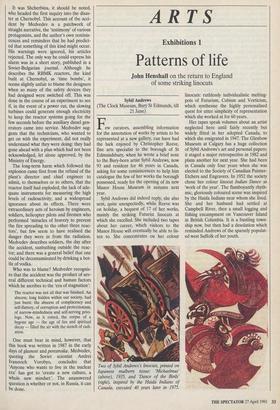ARTS
Exhibitions 1
Patterns of life
Sybil Andrews
(The Clock Museum, Bury St Edmunds, till
21 June)
Few curators, assembling information for the annotation of works by artists to be represented at a new gallery, can have had the luck enjoyed by Christopher Reeve, fine arts specialist to the borough of St Edmundsbury, when he wrote a brief note to the Bury-born artist Sybil Andrews, now 93 and resident for 46 years in Canada, asking for some reminiscences to help him catalogue the few of her works the borough possessed, ready for the opening of its new Manor House Museum in autumn next year.
Sybil Andrews did indeed reply; she also sent, quite unexpectedly, while Reeve was on holiday, a bequest of 17 of her works, mainly the striking Futurist linocuts at which she excelled. She included two tapes about her career, which visitors to the Manor House will eventually be able to lis- ten to. She concentrates on her colour Two of Sybil Andrews's linocuts, printed on Japanese mulberry tissue: Michaelmas' (above), 1935, and 'Dance of the Birds' (right), inspired by the Haida Indians of Canada, executed 40 years later in 1975. linocuts: ruthlessly individualistic melting- pots of Futurism, Cubism and Vorticism, which synthesise the highly personalised quest for utter simplicity of representation which she worked at for 60 years.
Her tapes speak volumes about an artist neglected here until fairly recently but widely feted in her adopted Canada, to which she emigrated in 1947. The Glenbow Museum at Calgary has a huge collection of Sybil Andrews's art and personal papers; it staged a major retrospective in 1982 and plans another for next year. She had been in Canada only four years when she was elected to the Society of Canadian Painter- Etchers and Engravers. In 1952 the society chose her colour linocut Indian Dance as `work of the year'. The flamboyantly rhyth- mic, gloriously coloured scene was inspired by the Haida Indians near whom she lived. She and her husband had settled at Campbell River, then a small logging and fishing encampment on Vancouver Island in British Columbia. It is a bustling town- ship now, but then had a desolation which reminded Andrews of the sparsely populat- ed west Suffolk of her youth. 'I'm delighted to give these works to the new Manor House Museum,' she says, 'and I'm especially pleased they'll go on show at the Clock Museum immediately. I have such memories of growing up in Bury, then living in a beautiful old cottage at Woolpit. My first studio overlooked where the Clock Museum now is, near the Abbey ruins. It may sound odd, but East Anglia has stayed with me all these years. When first I came to Canada, I thought, no — it's too deso- late. Then I got to identify with the foresters, the fishermen and the Indians. They've all featured in my linocuts — but so has Suffolk, too.'
Sybil Andrews studied drawing as a schoolgirl, then, after the Great War, met the Bury painter and architect Cyril Power (1872-1951). He encouraged her work and they had a joint exhibition at Bury in 1921. Two years later she went to Heatherley's School of Fine Art in London and learned woodblock printing, then drypoint printing on copper. During the Depression, she sup- ported herself by architectural views in the latter medium. She worked with Power again when they designed posters for London Transport in the 1930s.
The turning-point came when she moved to the Grosvenor School of Modern Art and studied under Claude Flight (1881-1955). She learned the linocut print- ing Flight had embraced after the Italian Futurist exhibition in London in 1912. It was dynamic, emphasised man's role in the brave new world of the machine age, and appealed greatly to Andrews. She used it even when tackling subjects quite uncon- nected with this notional age of socio- aesthetic innovation. Her whole oeuvre aimed at attaining simplicity of composi- tion and representation, and colour linocut was ideal. She called it 'the greatest teacher of all . . . you [were] forced to simplify your idea to its fundamentals'. She fea- tured prominently in the First Exhibition of British Linocuts in London in 1929; her works were in shows which toured the USA, Canada (at Ottawa), Australia, South Africa and China.
However, there was a problem with the deep-seated British aversion to modernism during the 1930s. Later, in Canada, Andrews recalled this: 'We had to live with the belief that linocuts (seen as avant- garde) were a child's form and "second- rate" art.' A cursory glance at this exhibi- tion shows that a singularly gifted child would have been required' to equal Andrews's masterly syntheses of East Anglian art, Russian icon-painting and tra- ditional Chinese and native Canadian art. When she married and left for Canada, she left this philistine nit-picking behind.
Her lifelong quest for simplicity, if never the simplistic, is reflected in works like Storm, Sledgehammer and The Mowers (all at Calgary). Of the men scything in the last she says, looking back to her youth in Suffolk: 'I used to see them in the field . . . it was like watching a ballet. I was interest- ed in the rhythms and patterns of life.' Her aims are also exemplified in Golgotha, Michaelmas and Dance of the Birds (anoth- er Haida motif), all on show at Bury. Many works are on exquisite Japanese mulberry tissue.
Sybil Andrews worked and taught until her mid-eighties. Now she will be repre- sented permanently in the Suffolk town of her birth. Bury's 20 or so works are supple- mented by 12 from the Michael Parkin Gallery, London, which are for sale.



















































 Previous page
Previous page